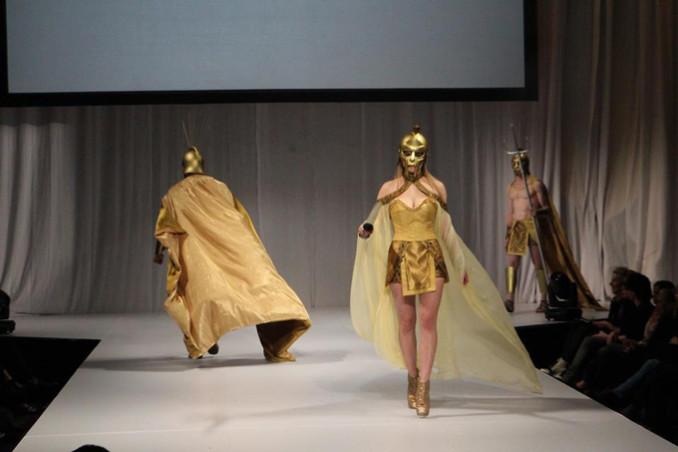This story has been updated with comment from Ryerson’s School of Fashion and creative industries students/faculty
By Brenda Molina-Navidad
Katie Ferreira and Amanda Ho, third-year Ryerson fashion communication students, were shocked when they found out they were not enrolled in a course for Mass Exodus—an annual end-of-year fashion event.
According to Ferreira and Ho, there was a high demand and limited number of seats in the two-semester fashion promotion course where students prepare and work on Mass Exodus—a course that students are encouraged to take before even being accepted into Ryerson’s school of fashion. Students say the School of Fashion promotes Mass Exodus as an opportunity to gain experience and exposure.
This course is one of the mandatory options given to third-year communication students, the other option being typography and graphic production (the course Ferreira and Ho were required to take).
Ferreira explained that faculty tells students before enrolment, in first year and the during their first class, that fashion students will have the opportunity to produce a show.
“Then you get to third year and you find out that only a quarter of your class got in,” she said.
After several attempts to speak with the school of fashion’s administration, Ferreira and Ho decided to take matters into their own hands by creating a petition on change.org. They are petitioning the Ryerson School of Fashion’s administration, including the Chair Sandra Tullio-Pow and the Dean of Faculty of Communication and Design, Charles Falzon. The petition has 145 signatures in the past week. On it, there are two requests—the first one being to increase the number of available seats in fashion promotion.
According to the two communication students the number of seats for the class dropped from 50 in 2015 to 36 in 2016.
The second request of the petition is to implement a ‘fashion communication students first’ policy to ensure that future students in the program are first-priority.
Daniel Drak, a contract lecturer and project strategist at Ryerson’s School of Fashion said through email that there were 36 students, but this number has recently increased to 44.
Of the 44 students, 30 are fashion communication students and 14 are creative industries students.
James Nadler, the Chair of Creative Industries, says that spots in the Mass Exodus course are reserved for creative industries students, but this year there was an administrative error by enrolment caught by student affairs coordinators. Nadler says it was a computer glitch and the promotion course was supposed to be made up of two-thirds fashion students and one-third creative industries students – with the recent increase fashion students now make up about 68 per cent of the class.
“We’re fine with other programs being able to take our courses…because it’s also an elective that they’re able to take, but if this is something that [fashion communication students] have to major in and study in, then it kind of sucks that they don’t get a spot,” said Young Eun Lee, a third-year fashion design student.
Karina Yehia, a third-year creative-industries student says that students in her program who are focusing their studies on fashion are not as prioritized as those in the fashion program and explained that fashion courses are limited.
“I can see where the [fashion communication students] are coming from, but everyone should have equal opportunities. We are interested in fashion as well and we kind of get the leftovers,” Yehia said.
The creative industries program offers education in a diverse range of creative fields including fashion. These students have the opportunity to gear their studies towards any creative field by completing two creative-modules by the end of their four-year program. There are thirteen modules to choose from –which they choose at the start of their first and second year. Each module consists of six courses.
Creative industries students who choose to narrow their studies in Fashion can choose ‘The Fashion Industry: Markets, Aesthetics and Creativity’ module, and it is in this module where fashion promotion is offered.
Nadler explained that the creative industries and fashion administration are working together to make the Mass exodus course work for everybody. He added that the course is a great opportunity for the creative industries and fashion communication students to learn from each other.
“The most important part of this is it’s not creative industries versus fashion..but it is to remember that we are one university,” he said.
As for the students who were unable to get in this year, Nadler says that creative industries students have the opportunity to enrol again and students are chosen for enrolment based on seniority and GPA.
Ho, the co-collaborator of the petition, says in the petition that enrolment is based on a luck-of-the-draw selection. Ho says she thought about enrolling in the class in her final year, but worried about the possibility of jeopardizing her fourth year due to the uncertainty of class space—meaning that she would have to return for an additional semester.
She hopes the petition is able to create change in their fashion program as well as her co-collaborator Ferreira.
“My goal would be for them to change it now,” said Ferreira, who is unsure of whether or not their requests are realistic.











Emily Skublics
The School of Fashion did not respond to interview requests, but why not ask a Creative Industries student how they feel about this attack against their right to learning opportunities? Creative Industries students are also promised the same chance to produce a show when they’re in first year. The entire program was created to break down school silos and encourage collaboration. Prioritizing the fashion students takes away this learning opportunity from Creative Industries students who are focusing their studies in fashion and goes against the team-playing collaborative nature that FCAD encourages and the fashion industry demands.
I was in this class last year. We were told on our first day that the class size was actually 35 students the previous year (2014-2015) and grew to 45. Also, Creative Industries students do not take it as an elective. Within the Fashion Industry module, it functions the same way it does for Fashion Communication students – you either get into this class or the alternative course, but it is mandatory to take one of them. There are Creative Industries students that don’t get in as well, and it is just as impactful upon them and their career prospects.
Emily Skublics
Thank you so much for updating this article to include balanced perspectives!
Cherise Cunningham
Creative Industries students are interdisciplinary students meaning that they have the opportunity to be (for example) a fashion student and a graphic communications and design student. The article makes it seem as if they are random business students who have no place in the course, when in reality they have chosen their program for the versatility and opportunity to take these courses, just as Fashion and Fashion Communication students did too. Instead of targeting the new program without fully grasping the context of how they study, I believe you should stick to the real problem, which is the lack of seats offered for the course.
Colleen Filson
I’m shocked that this article was cleared for posting. This article is full of factual errors regarding the Creative Industries program requirements and the actual class sizes for the Fashion Promotions course. The grounds of this petition are outrageous. That students at Ryerson are thinking in this hierarchal, self-entitled manner is harmful and petty.
Betsy Boo
It is a PRIVILEGE to be included in this fashion show, not your right. Passively-aggressively expensing a community of students (Creative Industries) whom specialize in this particular industry along with the Fashion Communications program for your benefit is not the way the world turns. In fact, it makes you look entitled, ignorant and petty.
No, you don’t pay an exclusive fee to attend the Mass Exodus course. It is luck of the draw. Nothing in this life is guaranteed, but what is? How you come across to your peers, colleagues and superiors. Honestly, you’re shooting yourself in your professional career foot by whining about this. We all have the opportunity to learn, THAT is our privilege because we through the nose for it. But feeling “bold” to say you deserve something over the other? Welcome to the Darwinian effect, baby.
A “scarce” 22 fashion students are only able to enlist in the course? Seriously? What is scarce about that? Let’s look at the ratio here: For every 22 fashion students whom enlist in this course, 14 Creative Industries students are included. Isn’t that “priority”? Now you’re asking for more? Adapt to change, people.
Sarah
The most logical thing to do is have the enrolment system first come first serve. It does not make sense to to let people in based on a lottery system. Other universities follow the first come first serve and is able to make schedules way before Ryerson gets their act together. I intended for my electives on time and have been rejected, forcing me to take courses that I have no interest or relevance to my field. I know people who intend their courses late and have taken my spot. It’s ridiculous how archaic School of Fashion is when you want to switch sections. You need to have a religious or medical excuse. We are paying you to accommodate us, Ryerson! We should have the power to modify our schedule -NOT look for someone to switch classes with and have to do it manually through the administrator.
Quincy
As a Creative Industries student who is not enrolled in the Fashion Module, I am merely basing my opinion on hearsay. However, how this article was cleared is beyond my comprehension. A have experienced similar sentiments of jealousy and anger over being enrolled in what are mandatory courses in the Theatre School and “stealing” spots from “real” students. Considering that I am in the Acting/Dance module, these courses are required for me as well and I need to take them in order to graduate. This kind of thinking hurts the collaborative nature of our program because what ends up happening is Creative Industries students end up just collaborating with themselves. They would rather work with open individuals than deal with petty and childish attitudes from students from other majors.
And to respond to Ferreira’s comment, no. Your expectations are not realistic, and not indicative of what is going to happen in the real world. What are you going to do if there are not enough jobs available for you all when you graduate?
Start a petition?